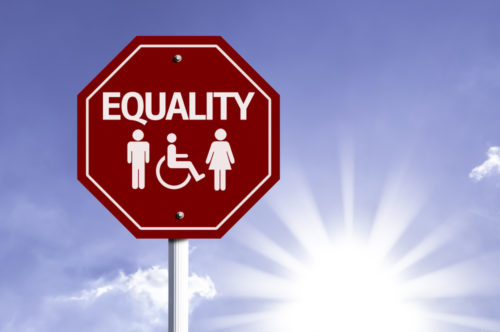There are many different types of discrimination. Some types of discrimination are more obvious and direct while, others are indirect or without malice. However, both types are serious matters affecting the equality of people with disabilities everywhere. Addressing disability discrimination is not an easy subject to tackle, but it’s an important subject to take seriously.
In order to feel educated about the issue, it’s important to understand the legal definition of disability discrimination, be aware of some common examples, and understand what to do if you encounter it.
Table of Contents
Legal Definition of Disability Discrimination
According to the Americans with Disabilities Act (ADA), Disability discrimination occurs when an employer treats a qualified individual with a disability who is an employee (or applicant) unfavorably because they have a disability. This includes discrimination based on a history of disability, if the disability is not permanent or minor, or discrimination based on a relationship with someone with a disability — such as a child or spouse with a disability.
The law requires that an employer must provide reasonable accommodation to an employee or job applicant with a disability, unless doing so would cause significant expense to the employer. The protection involves things like harassment, discrimination, accommodation, and medical treatment.
The Rehabilitation Act of 1973
Both the ADA and the Rehabilitation Act of 1973 protect people with mental or physical disabilities from discrimination. The differences between the two have to do with the institutions that fall within each act’s requirements.
The ADA prohibits discrimination on the basis of disability in employment, state and local government, public accommodations, commercial facilities, transportation, and telecommunications.
The Rehabilitation Act prohibits discrimination on the basis of disability in programs conducted by federal agencies, in programs receiving federal financial assistance, in federal employment, and in the employment practices of federal contractors.
Examples of Disability Discrimination in the Workplace
There are many different types of workplace discrimination. Sometimes it can be difficult to tell if you’re experiencing a reasonable company policy, or the ramifications of a discriminatory policy. These are a few examples of disability discrimination in the workplace:
- Not being provided with regular breaks as necessitated by a condition
If you are diabetic, for instance, and you aren’t provided with regular breaks as necessitated by this condition, this is a form of disability discrimination in the workplace.
- Being fired for disability-related absences
If you’re fired from you position due to disability-related absences, this could be considered disability discrimination. However, according to the U.S. Equal Employment Opportunity Commission, there are many circumstances within these situations that require the agreement of both the employer and the employee to cooperatively manage these absences.
- Being denied reasonable accommodation
If an employee has a hip replacement and requests a stool to sit on instead of standing, that’s considered a reasonable accommodation to a disability. Failure to make such accommodations might also mean being denied a closer parking space, not being provided with extra mentorship, or not being able to work from home if your position allows it.
- Being denied employment due to a negative reference regarding disability
Not only is it workplace discrimination to not hire or fire someone due to disability, it’s also workplace discrimination to give a negative reference to a former employee’s prospective employer if the negative feedback has to do with their disability.
- Being denied reasonable reallocation of duties
If you suffer from depression and need to be moved from a client-facing position to a role away from the public, being denied this change in duties can be considered discrimination if the move is reasonable.
What To Do About Disability Discrimination
If you witness or experience disability discrimination in the workplace, it’s important to understand what the next steps should be.
Know Your Rights
Knowing your rights is the most important aspect in the beginning stages of an issue with disability discrimination. Not only should you know what constitutes discrimination and what your rights are, but also what you need to do in order to benefit from those rights.
For one, it’s important to note that you won’t benefit from protections under the ADA unless you decide to disclose your condition to your employer. This is a personal decision you must make for yourself, but understand your legal limitations in regards to discrimination if you choose not to disclose this information.
Take Notes
Taking notes and keeping records of any instances of disability discrimination is extremely important. This might include making a note of the discussion you have with your employer when you disclose your disability, any photos that could help provide proof, and any correspondence. Even if your complaints don’t go further than a discussion with HR, it’s still helpful to have this information. In a trial situation, you’ll be the first to have the burden of proof. For this reason, your notes can be really helpful in your case.
File a Complaint at Work
Filing a complaint at work is a great way to advocate for yourself and discuss your rights and abilities with your employer. When you file a harassment complaint at work, you’ll want to report to your human resources department. You may have information outlined in your employee handbook on how to handle this type of complaint. In many cases, any discrimination you’re experiencing can be fixed through this channel. Your HR department is there to help facilitate these issues and work through any concerns of discrimination. If your issue remains unsolved, you may need to take further steps.
File a Complaint With the EEOC
The EEOC, or the Equal Employment Opportunity Commission, is responsible for investigating charges of job discrimination related to disability discrimination. Most states have their own agencies that enforce state laws against disability discrimination. You’ll want to file a charge of discrimination. The time limit for filing a charge is normally 180 days from the day the discrimination took place. You can complete the charge online and your employer will be notified and your charge will move through the investigation timeline.
Consider a Discrimination Lawsuit
You cannot file a discrimination lawsuit against your employer until you’ve filed a charge of discrimination with the EEOC. Once you’ve done this, you should receive a “right-to-sue” letter which allows you to proceed through the courts with your claim. A discrimination lawsuit is basically the highest level of justice you can receive as a result of discrimination due to your disability.
Disability discrimination isn’t an issue that looks the same for everyone. Each workplace, state, and disability comes with it a different understanding of disability discrimination. However, it’s important to be aware of your rights. Even if your workplace isn’t intentionally being discriminatory or your disability isn’t long-term or visible, you are still protected by disability discrimination laws at your place of work. Sometimes repairing the issue is as easy as explaining your rights to your employers, other times further legal action is need. Either way, you’re entitled to certain rights as an employee.
Image Source: https://depositphotos.com/





